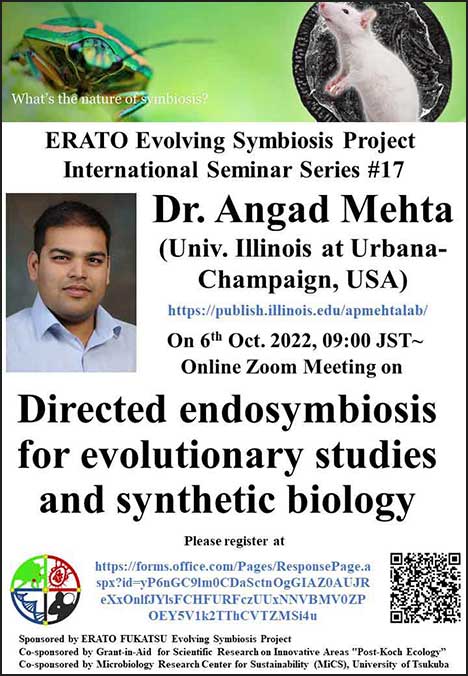第17回共生進化機構国際セミナーをオンライン開催しました。
細胞内共生の実験的構築の研究で知られるDr. Angad Mehta(University of Illinois at Urbana-Champaign, USA)にご講演いただきました。

Abstract:In this talk, I will discuss our investigations on engineering genetically tractable synthetic endosymbionts in genetically tractable host cells; we call this process “directed endosymbiosis”. The two key areas of research that I will discuss are: (i) engineering artificial photosynthetic organisms through directed endosymbiosis, and (ii) engineering yeast/E. coli endosymbiosis to study mitochondrial origin. First part of my talk is inspired from evolutionary observations that suggests that chloroplasts evolved from cyanobacterial endosymbionts established within eukaryotic cells more than billion years back. This endosymbiotic event led to the origin of photosynthetic eukaryotic life-forms, and drastically impacted global ecology. And yet we have little to no idea of how bacterial endosymbionts actually transformed into organelles. These fascinating observations inspired us to develop artificial, synthetic endosymbiosis between model cyanobacteria (as endosymbiont) and budding yeast (as host). Particularly, we engineered cyanobacteria to perform chloroplast-like functions for the host yeast cells, where cyanobacteria provide photosynthetically generated ATP and/or assimilated carbon to the host yeast cells and the yeast cells provide essential metabolites to the engineered cyanobacterial endosymbionts. Thorough series of cyanobacterial and yeast engineering efforts we were able to engineer yeast/cyanobacteria chimeras that were able to propagate through at least 15 to 20 generations of growth under optimal photosynthetic growth conditions. Engineered yeast/cyanobacteria chimeras were characterized biochemically and by using a range of microscopy techniques. Using this bottom-up engineering approach we determined critical genetic elements that are necessary to establish synthetic endosymbiosis between cyanobacteria and eukaryotic cells. We are also using this directed endosymbiosis platform to attain minimal endosymbiont genomes for photosynthetic cyanobacteria. Such photosynthetic endosymbiotic systems could provide a platform to recapitulate various evolutionary trajectories related to the conversion of photosynthetic endosymbionts into photosynthetic organelles (i.e., chloroplasts), and are therefore, expected to have significant implications on the evolutionary origin of photosynthetic eukaryotic life-forms. Further, we anticipate that genetically tractable photosynthetic platforms, where the endosymbiont provide ATP and assimilated carbon sources by photosynthesis will have significant implications on synthetic biology applications. In the next part of my talk, I will describe our directed endosymbiosis efforts to study early stages of mitochondrial evolution. It has been hypothesized that mitochondria evolved from a bacterial ancestor that initially became established in an archaeal host cell as an endosymbiont. We modeled this first stage of mitochondrial evolution by engineering endosymbiosis between E. coli and yeasts. An ADP/ATP translocase-expressing E. coli provided ATP to a respiration-deficient yeast mutant and enabled growth of a yeast–E. coli chimera under respiration growth conditions. In a reciprocal fashion, yeast provided thiamin to an endosymbiotic E. coli thiamin auxotroph. Expression of several SNARE-like proteins in E. coli was also required, likely to block lysosomal degradation of intracellular bacteria. This readily manipulated chimeric system should allow us to investigate various aspects of the endosymbiotic theory of mitochondrial evolution.
ERATO Evolving Symbiosis Project International Seminar Series #17
第17回共生進化機構国際セミナー
Sponsored by ERATO FUKATSU Evolving Symbiosis Project
主催:ERATO深津共生進化機構プロジェクト
https://www.jst.go.jp/erato/fukatsu/
Co-sponsored by Grant-in-Aid for Scientific Research on Innovative Areas "Post-Koch Ecology”
共催:新学術領域研究「ポストコッホ生態」
https://postkoch.jp/about/
Co-sponsored by Microbiology Research Center for Sustainability (MiCS), University of Tsukuba
共催:筑波大学微生物サステイナビリティ研究センター(MiCS)
https://www.mics.tsukuba.ac.jp/


